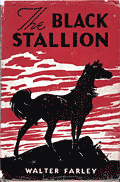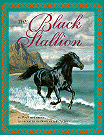The Black Stallion (1941)
 A shipwreck leaves young Alec stranded on a deserted island with a wild stallion. Dependent on each other for survival, boy and horse learn to trust and love each other as they establish an amazing friendship that lasts a lifetime. Pulled to a desert island by a wild black stallion he has freed during a shipwreck at sea, then rescued by a southbound freighter, a seventeen-year-old boy befriends the horse, trains him by night, and rides him to victory in a match race.
A shipwreck leaves young Alec stranded on a deserted island with a wild stallion. Dependent on each other for survival, boy and horse learn to trust and love each other as they establish an amazing friendship that lasts a lifetime. Pulled to a desert island by a wild black stallion he has freed during a shipwreck at sea, then rescued by a southbound freighter, a seventeen-year-old boy befriends the horse, trains him by night, and rides him to victory in a match race.
First printed as “The Black Stallion” – 1941 Random House
Art: Keith Ward
Now available: “The Black Stallion” – 1941 Retro Edition
New printing of the original 1941 edition of The Black Stallion. Hardback, B&W illustrations by Kieth Ward – Benefits the Black Stallion Literacy Project, thank you!
Click here to buy it now!
At the Gift Shop you can buy Black Stallion books and other products.
Click here to visit the Gift Shop now!
The Anniversary Edition – 1991
 The Black Stallion
The Black Stallion
Anniversary Edition (September 1991),
Random House
The Birth of The Black Stallion – The Family Remembers
When The Black Stallion was published on October 15, 1941, its author was entirely unknown. Twenty-six-year-old Walter Farley had never even written a short story before. The publication of his first novel, it soon turned out, marked the launching of both a saga and a career.
Young readers were enthralled by his gripping tale of a horse loving boy named Alec Ramsey who befriends a wild black stallion. Farley went on to devote the rest of his life to writing about the Black and other horses. By the time of his death in 1989, two weeks before the publication of his twenty-first Stallion novel, the Black had become the most famous fictional horse of the century. The Black Stallion and his creator were known around the world, thanks to uncounted millions of books sold in more than twenty languages and two successful movies. So popular have the books remained that in fifty years not one of the Stallion novels has ever gone out of print.
Who was this young writer who astonished the children’s book world in 1941? How did Walter Farley come to write The Black Stallion? What was his experience with horses? What made his fiction so authentic? For the occasion of the novel’s fiftieth anniversary, on October 15, 1991, three members of the Farley family contributed their separate memories of the author’s :early days. Their voices have been interwoven here, along with a few voices from the past, including Walter Farley’s own.
The family members are Rosemary Lutz Farley, the author’s wife; Dr. William J. “Bill” Farley, the author’s brother (two years younger and his only sibling); and Steve Farley, the author’s first son, now a writer himself continuing the Black Stallion saga.
Here is what they remember:
ROSEMARY FARLEY: Through history there have always been people who have a special bond with horses. Walter Farley was one of that special breed.
STEVE FARLEY: Just as there are dog people and cat people, there are “horse people.” My father was a horse person.
BILL FARLEY: Walter’s life was a love affair with the horse. His first and favorite toys were a black iron horse and a trotting horse and driver in a racing sulky.
ROSEMARY FARLEY: Bill remembers the black iron horse well since he was clobbered with it occasionally.
BILL FARLEY: We lived in the lower six rooms of a two-story house in Syracuse, New York, in a section called Tipperary Hill because of its large Irish population. Each year we went with our parents to the New York State Fair near Syracuse for the Hamiltonian Stakes and a week of trotting races. Summer vacations were spent at Aunt Doll’s on Oneida Lake, with Mr. Messinger’s farm nearby. Walter was up on the farm horses at every opportunity.
WALTER FARLEY: My great love was horses. I wanted a pony as much as any boy or girl could possibly want anything, but I never owned one.
ROSEMARY FARLEY: Walter entered every contest that had a horse or a pony for a prize. To his parents’ relief, he never won. But among his mother’s papers (found after her death years later) was a picture of. a black pony. On the back she had written, ‘The only pony Walter ever had. Sorry. Mother.” She also had saved a third-grade composition, a story about a big black horse.
BILL FARLEY: As a teenager, Walter often hitchhiked to our Uncle Bill’s riding stables out Fayetteville way, frequently playing hooky okay and sleeping over in the hay. Uncle Bill was an excellent horseman, teacher and trainer of show horses and their young riders (mostly young ladies, an added attraction for Walter). He later took up training racehorses at Belmont Park on Long Island, after we all moved to New York City. Walter spent as much time with Uncle Bill as he could.
WALTER FARLEY: He wasn’t t the most successful trainer of racehorses, and in a way I profited by it. He switched from runners to jumpers to show horses to trotters and pacers, then back to runners again. Consequently, I received a good background in different kinds of horse training and the people associated with each.
BiLL FARLEY: Walter had three major interests while growing up; school was not one of them. They were horses, running and girls, not always in that order. He was never left back in school but frequently just made the next grade. Most of his compositions were horse stories, and on the white-lined paper usually there was a drawing of a horse in black crayon.
ROSEMARY FARLEY: Outside of school his father (who was once a catcher in semipro baseball) encouraged sports. Walter said his father gave his boys the best equipment so they would have no excuse for losing. This encouragement worked.
BILL FARLEY: Walter had the athletic ability to play any sport. He played tennis very well as a boy. He and I were finalists in a boys’ championship in Syracuse. I won, but I always felt that Walter let me win in order to encourage me to continue to play competitive tennis, which I subsequently did. Walter was unquestionably the best runner on a block with many boys. Because of his running ability, he also became an excellent speed skater. While at Porter Junior High School he entered the Syracuse Junior Olympics, an annual citywide competition, and won the championship in his age group.
ROSEMARY FARLEY: All his sports were for loners. This may be the best training for a writer, a solitary occupation if there ever was one. And this may have been the way Walter learned not only how to be Alec, but the Black as well.
BiLL FARLEY: Walter attended Syracuse Central High School and made the track team. After Prohibition ended in 1933, our family moved to New York City and our dad returned to the hotel business as manager of the bars and grill rooms of the Hotel Roosevelt. Walter enrolled in Erasmus Hall High in Brooklyn because they had a good track team, even though he did not live in that school district. At Erasmus Hall he was a member of their city-champion mile relay team.
BiLL FARLEY: Because of his track records at Erasmus Hall, Walter received an athletic scholarship to Mercersburg Academy in Mercersburg, Pennsylvania, which also had an outstanding track team. Mercersburg turned him around academically through the encouragement and interest of his teachers, especially the faculty adviser for the school newspaper. Walter became a reporter for the newspaper and an “A” student. While enrolled at Mercersburg he kept working on his story of the wild black stallion. He graduated in 1935 with honors.
ROSEMARY FARLEY: After Walter left Mercersburg he needed a job and advertising was writing of a sort. It was difficult to break into an ad agency. He started as a messenger and then taught himself enough to become a copywriter. He enjoyed writing advertising slogans, but his heart was in his book and the freedom of being a creative writer.
WALTER FARLEY: You ought to pursue your hobby . . . not become a lawyer so you can spend your spare time pursuing your hobby.
BILL FARLEY: Walter entered the School of Journalism at Columbia University, attending at night. He eventually took a course on juvenile writing given by Professor Mabel Louise Robinson, who was herself a well-known author of children’s books. The Black readers. Walter’s story was an immediate success when it was published in October 1941. But our entrance into World War 2 less than two months later delayed his plans for a sequel. The draft board beckoned and put Walter in the army. He spent most of the war as a reporter for Yank the army magazine. While stationed in Alaska, he and author Dashiell Hammett, also a reporter, accompanied long-range bombing missions into northern Japan. During the long arctic winter and plane flights, The Black Stallion Returns was born. With the war winding down, Walter was reassigned to New York City in 1944. As always, he got to know all the best looking girls in the neighborhood, which included Fifth Avenue and the John Robert Powers Modeling Agency. There he met Rosemary Lutz, a stunning model with a degree in political science from the University of Pittsburgh. Before long he was announcing his plans to get married and make a living as a writer of children’s books.
EOUlSE BONINO (Walter Farley s editor): As quoted in Black Stallion publishing lore Don’t figure on making any money writing children’s books.
![]() In a letter to the author dated February 8, 1945: Your desire to devote yourself exclusively to writing after the war is perfectly natural, but I know of only one writer of teenage books who has managed to come pretty close to what you’re after. Even he admitted to me once that if he were to depend on book royalties alone, he wouldn’t be able to support his family. The last thing in the world I’d want to do would be to crush an extremely worthwhile ambition, but I would feel remiss both as a friend and as a publisher if I didn’t caution you to do some careful arithmetic before you decide to burn your bridges.
In a letter to the author dated February 8, 1945: Your desire to devote yourself exclusively to writing after the war is perfectly natural, but I know of only one writer of teenage books who has managed to come pretty close to what you’re after. Even he admitted to me once that if he were to depend on book royalties alone, he wouldn’t be able to support his family. The last thing in the world I’d want to do would be to crush an extremely worthwhile ambition, but I would feel remiss both as a friend and as a publisher if I didn’t caution you to do some careful arithmetic before you decide to burn your bridges.
ROSEMARY FARLEY: I did not meet Walter until three years after The Black Stallion was published. On our second date we were riding in Central Park. For the next forty-five years I lived with the man and his horse, the Black. Although we had real live horses and ponies, the center of his life was that paper horse galloping through his studio or wherever he had a typewriter in front of him. On his office wall he had a note to himself “Money is necessary, but it isn’t too important.” Money meant for him the opportunity to keep on writing and to go his own way. So despite Louise Bonino’s discouraging words we decided to take a chance. We were married in May 1945 and moved to a farm in Pennsylvania that we bought for very little. It had a big garden and we thought if worst came to worst, we could always survive on vegetables. I kept working as a model while Walter wrote in a converted chicken coop. When the wartime paper restrictions were lifted, Random House published The Black Stallion Returns, in October 1 945. To our pleasure, and Random’s, the royalty checks became bigger and bigger. Walter knew just what he wanted to do and set up a schedule of a book a year for the next five years and more. He kept to the schedule.
STEVE FARLEY: My father loved to write, but I think he loved the research part of his work even more. Research for him was being around a horse. He championed Arabians, but he would go wherever one might expect to find horses of any breed. He would go to meet the people who worked with them, from a county fair near Harrisburg, Pennsylvania, to the racetrack at Hialeah. And he would go to watch the spectators in the grandstand. In his own words, “I love to look at people looking at horses.” Usually he went alone to do his research, but there were times he would bring me or my brother or sisters with him to haunt some stable area or hang along a fence rail.
![]() Over the years he made friends with jockeys, drivers, trainers, grooms, owners, sports reporters, circus performers and many other professionals in the horse business. These people and their stories imbued his books with authenticity as much as his own dreams charged them with imagination. Though he never claimed to be a professional horseman himself, he certainly rubbed shoulders with the horse world in a very big way. More than anything else he was a window to that world for horse loving people everywhere.
Over the years he made friends with jockeys, drivers, trainers, grooms, owners, sports reporters, circus performers and many other professionals in the horse business. These people and their stories imbued his books with authenticity as much as his own dreams charged them with imagination. Though he never claimed to be a professional horseman himself, he certainly rubbed shoulders with the horse world in a very big way. More than anything else he was a window to that world for horse loving people everywhere.
WALTER FARLEY: I believe half the trouble in the world comes from people asking “What have I achieved?” rather than “What have I enjoyed?” I’ve been writing about a subject I love as long as I can remember, horses and the people associated with them, anyplace, anywhere, anytime. I couldn’t be happier knowing that young people are reading my books. But even more important to me is that I’ve enjoyed so much the writing of them.
